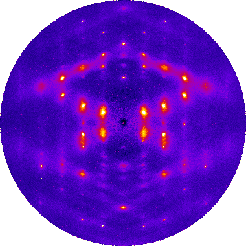
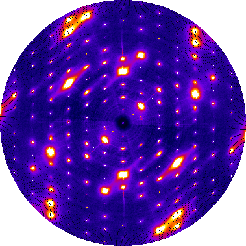
A single frame from the 3D synchrotron X-ray data collection
for 4,4'-dimethoxybenzil
together with a reconstructed plane section
(h0l) obtained from 500 such frame
Physical and Theoretical Chemistry
 This group combines diffuse X-ray scattering methods with
computer simulation to deduce the arrangement of atoms and molecules
in disordered crystals. Conventional crystal structure determination
reveals only averaged arrangements, inadequate to explain some of the
basic properties of many minerals, inorganic compounds, organic
compounds and alloys that exhibit crystalline disorder. Diffuse
scattering gives information on how neighbouring atoms or molecules
interact with each other. Quantitative studies of diffuse scattering
are, however, still rare because of the intrinsically very low
intensities involved.
This group combines diffuse X-ray scattering methods with
computer simulation to deduce the arrangement of atoms and molecules
in disordered crystals. Conventional crystal structure determination
reveals only averaged arrangements, inadequate to explain some of the
basic properties of many minerals, inorganic compounds, organic
compounds and alloys that exhibit crystalline disorder. Diffuse
scattering gives information on how neighbouring atoms or molecules
interact with each other. Quantitative studies of diffuse scattering
are, however, still rare because of the intrinsically very low
intensities involved.
The group uses dedicated diffuse-scattering diffractometer systems based on curved position-sensitive wire detectors. These allow high quality diffuse scattering data to be efficiently recorded over large regions of diffraction space and provide a unique facility for tackling a whole range of complex structural problems. The group also has access to the most advanced synchrotron radiation and neutron source facilities in the world and methods are being developed to utilize these for diffuse scattering measurements.
The group’s interests span a wide range of different fields, each presenting problems for which this specialised technique can give unique information. Areas in which we have applied the techniques include: disordered molecular crystals, guest/host systems such as urea inclusion compounds, non-stoichiometric inorganic materials and minerals (for example, the cubic stabilised zirconias, mullite and wüstite), flexible framework structures such as silica polymorphs and their analogues, alloys, and quasicrystal phases.
Much of the current effort of the group is concerned with the further development and exploitation of the least-squares method for directly fitting a Monte Carlo (MC) simulation to observed X-ray diffraction data, proposed for the first time in 1997. This work is supported by an ARC Discovery Grant. A second ARC Discovery Grant is held jointly with the Withers Group and supports work to investigate the role of strain in disordered systems.
The current main emphasis of the work on the automatic refinement method is to develop the techniques whereby the diffuse scattering from a molecular crystal can be measured and analysed on a routine basis. Progress has been made on two fronts. First, we have undertaken a series of synchrotron experiments to collect diffuse scattering data. Instead of the single 2D plane sections of diffuse scattering data that can be measured at ANU, it is possible to collect a complete 3D data set in less than 24 hours at the APS in Chicago. However the need to measure very weak intensities in the presence of the very strong Bragg peaks presented non-trivial problems that had to be solved to obtain data of a comparable quality to those obtained with our laboratory-based methods. The figure below shows an example of the synchrotron radiation data obtained for 4,4'-dimethoxybenzil. On a second front a number of software tools have been developed to aid in the setting up, model design and running of the Monte Carlo simulation program that is used to analyse the diffuse scattering data. Whereas previously each new project required the setting up of a purpose-built Monte Carlo program involving many weeks of development it is now feasible to use a generic program that can be tailored to suit different systems in a much shorter time.
Current studies are concentrating on molecular systems containing more internal degrees of flexibility than the original benzil archetype. Data have been collected for the three isomers 2,2'-dimethoxybenzil, 3,3'-dimethoxybenzil and 4,4'-dimethoxybenzil, each of which has five internal degrees of flexibility. Each of these has a perfectly normal average structure as determined by conventional crystallography but nevertheless exhibits strong diffuse scattering. A preliminary study of 4,4'-dimethoxybenzil has been published during the year but it is intended that this work be extended now that more extensive synchrotron data is available. In addition data has been collected for 4 Cl, 4’-methylbenzil which contains additional occupational disorder. Such analyses provide information on how the molecules interact with each other that is not available from conventional crystal structure determinations. (with D.J. Goossens, A.P. Heerdegen, and D.R.Haeffner, P.L. Lee, J. Almer [APS, Argonne USA])


A single frame from the 3D synchrotron X-ray data collection
for 4,4'-dimethoxybenzil
together with a reconstructed plane section
(h0l) obtained from 500 such frame
Diffuse neutron scattering data have been recorded for the molecular crystal d10-benzil, C14D10O2 using the time-of-flight (tof) Laue technique instruments at ISIS. Using SXD it was possible to access a large fraction of the total 3D reciprocal space out to a Q of 15 Å-1. By segregating the scattered data according to the incident neutron energy used, patterns were obtained from those neutrons in the range ~20meV-150meV which showed little sign of inelastic effects and so could be compared to previously analysed X-ray data. For neutron energies <20meV interesting inelastic effects were observed which have been used to obtain an estimate for the energy of phonons associated with a vibrational mode in which an intra-molecular mode couples to a low-energy shearing motion of the molecular network. The estimated value of 8.95cm-1 (1.11meV) for this mode is less than the lowest energy mode reported from spectroscopic measurements for hydrogenous benzil (~16cm-1). A model previously derived from analysis of X-ray data observed over a limited range of Q has been used to calculate neutron patterns over the full Q range. Comparison with the present neutron data has shown that while the model gives a good description of the form of the diffuse patterns, the magnitudes of the atomic displacements in the X-ray study were underestimated by a factor of ~2.25. (with D.J. Goossens, A.P. Heerdegen, and W.I.F. David, M.J. Gutmann, M.J. Bull [ISIS, Oxon UK])
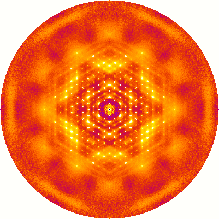
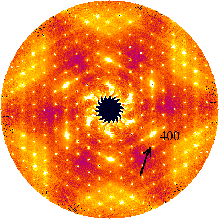
Diffuse neutron scattering pattern of d10-benzil out
to Q=4π sin(θ)/&lambda=15Å-1
together a
lower Q pattern obtained using low energy neutrons that
displays
inelastic effects
Monte Carlo simulation modelling techniques have been used to demonstrate that in two quite different systems the observed highly structured diffuse scattering can be explained in terms of a simple model involving a multi-site interaction originating from a local crystal chemistry constraint. The local chemical 'rule' produces a local strain and the structure has to find a way of alleviating this. The two examples studied involve O/F ordering in K3MoO3F3 (see 2002 annual report) and Bi/Zn cation ordering in the cubic pyrochlore (Bi1.5Zn0.5)(Zn0.5Nb1.5)O7. This is important because diffuse scattering is the Fourier transform of only the pair-correlation distribution and any structure that originates from multi-site interactions can only be observed indirectly. In BZN the basic driving force is the requirement that each (Zn/Bi)4O tetrahedron has 3Bi and one Zn. Then the sides of the originally regular tetrahedron are strained so that Bi-Zn edges are smaller than average and Bi-Bi edges are larger than average. This simple mechanism produces in the Monte Carlo simulation the pattern of atomic displacements (shown in the figure below) that are in agreement with observations. (with R.L. Withers, Y. Liu, L. Norén, F.J. Brink, and A.-K. Larsson [RSPSE, ANU], and H. Rundlöf [Uppsala U. Sweden])
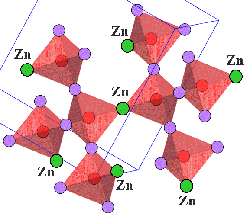
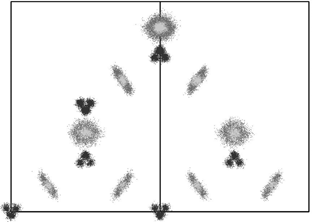
Ordering of Bi and Zn on the corner-connected tetrahedral network in
BZN together
with displacement patterns generated in the Monte Carlo
model as a result of local
constraints.